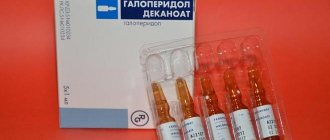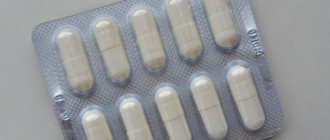Pharmacological properties of the drug Mexicor
Pharmacodynamics . The drug has anti-ischemic, antianginal, antihypoxic, angioprotective, hypocholesterolemic effects. Mexicor reduces the manifestations of oxidative stress, inhibits free radical lipid peroxidation and increases the activity of the antioxidant enzyme system. The drug improves cellular energy metabolism, activates the energy-synthesizing functions of mitochondria, enhances the compensatory activation of aerobic glycolysis and reduces the degree of inhibition of the oxidative processes of the Krebs cycle. The energy-synthesizing effect of the drug is associated with an increase in the supply and consumption of succinate by cells, the implementation of the phenomenon of rapid oxidation of succinic acid by succinate dehydrogenase, as well as with the activation of the mitochondrial respiratory chain. When the drug dissociates in the cell into succinate and 3-hydroxypyridine factor, a powerful antioxidant effect is manifested, which stabilizes cell membranes and restores the functional activity of cells. The drug reduces viscosity and improves blood fluidity. Helps maintain the structural and functional integrity of biomembranes, improves the transport of neurotransmitters and synaptic transmission. The basis of the drug’s action is its antioxidant activity, the ability to inhibit free radical processes (intensification of which is observed during myocardial ischemia and necrosis, especially during the period of reperfusion), and reduce the damaging effect of free radicals on cardiomyocytes. Mexicor improves the functional state of ischemic myocardium, reduces the manifestations of systolic and diastolic dysfunction of the left ventricle, as well as electrical instability of the myocardium. In conditions of coronary insufficiency, the drug increases collateral circulation of the ischemic myocardium and activates energy-synthesizing processes in the ischemic zone, which helps maintain the integrity of cardiomyocytes and their functional activity. In conditions of a critical decrease in coronary circulation, Mexicor helps preserve the structural and functional organization of cardiomyocyte membranes, stimulates the activity of membrane enzymes - PDE, adenylate cyclase, acetylcholinesterase. The drug supports the activation of aerobic glycolysis that develops during acute ischemia and promotes the restoration of mitochondrial redox processes under hypoxic conditions, increases the synthesis of ATP and creatine phosphate. These mechanisms ensure the integrity of the morphological structures and physiological functions of the ischemic myocardium. Mexicor normalizes metabolic processes in the ischemic myocardium, reduces the area of necrosis, restores and/or improves the electrical activity and contractility of the myocardium, and also increases coronary circulation in the ischemic zone, increases the antianginal activity of nitro drugs, improves the rheological properties of blood, reduces the consequences of reperfusion syndrome in acute coronary insufficiency . Mexicor effectively restores myocardial contractility in case of reversible cardiac dysfunction caused by the state of hibernation and stunned myocardium, which is a reserve for increasing cardiac contractility in patients with coronary artery disease complicated by heart failure. In patients with stable angina pectoris, Mexicor increases exercise tolerance and the antianginal activity of nitro drugs, improves the rheological properties of blood, and reduces the incidence of acute coronary insufficiency. Additional use of Mexicor as part of standard therapy for patients with coronary artery disease and chronic heart failure has a positive effect on the clinical condition of patients, increasing exercise tolerance and improving quality of life. Mexicor increases the effectiveness of antiarrhythmic therapy due to its own antiarrhythmic activity, and also reduces the likelihood of developing cardiac side effects of the main antiarrhythmic drugs, maintaining or enhancing their specific activity. Mexicor stabilizes the membrane structures of the vascular wall, inhibits platelet aggregation, normalizes impaired microcirculation in the early stages of atherogenesis, and has a lipid-correcting effect on the ratio of pro- and antiatherogenic fractions of blood lipids. Reduces the level of VLDL cholesterol, LDL cholesterol and TG while simultaneously increasing HDL cholesterol. The use of Mexicor in the complex therapy of patients with coronary artery disease with a hypertension crisis (arterial hypertension) shortens the period of post-crisis stabilization of the condition, reduces the reliability of the recurrence of a hypertensive crisis and the incidence of acute coronary insufficiency during the crisis, and enhances the hypotensive effect of ACE inhibitors and β-adrenergic receptor blockers. Mexicor has a neuroprotective effect, improving cerebral circulation in conditions of hyperperfusion, and improves cerebral blood flow during the reperfusion period after ischemia. The drug promotes adaptation to the damaging effects of ischemia, inhibits the depletion of carbohydrate reserves, inhibiting the post-ischemic decrease in the utilization of glucose and oxygen by the brain and prevents the progressive accumulation of lactate. At the same time, the indicators of autoregulatory reactions of cerebral vessels improve. Mexicor has a nootropic effect, prevents and reduces learning and memory impairments that occur in acute and chronic vascular diseases of the brain, mild and moderate cognitive impairment of various origins, has an antioxidant effect, increases the ability to concentrate and work ability. The inclusion of the drug Mexicor in the complex therapy of patients with acute circulatory disorders reduces the manifestations of clinical symptoms of stroke and improves the course of the rehabilitation period. Mexicor exhibits a selective anxiolytic effect, not accompanied by sedation and muscle relaxation, eliminates feelings of anxiety, fear, mental stress, restlessness, increases adaptation and improves emotional state. Pharmacokinetics . Capsules. After oral administration, Mexicor is quickly and completely absorbed into the gastrointestinal tract. The half-absorption period is 0.08–0.1 hours. The time to reach maximum concentration in the blood plasma is 0.46–0.5 hours. Cmax in the blood plasma is in the range from 50 to 100 ng/ml. Mexicor is extensively metabolized in the liver to form phosphate-3-hydroxypyridine and glucurone-conjugated products. The half-life of Mexicor is 4.7–5 hours. On average, 0.3% of the unchanged drug and 50% of the administered dose in the form of glucuron conjugate are excreted in the urine over 12 hours. Mexicor and its glucuron conjugates are excreted most intensively in the first 4 hours after taking the drug. Solution for intravenous and intramuscular administration. When administered intravenously, the drug quickly (within 0.5–1.5 hours) enters organs and tissues, and therefore its unchanged concentration in the blood quickly decreases. When administered intramuscularly in therapeutic doses, the concentration of the drug in the blood plasma is achieved after 30–40 minutes and is 2.5–3 μg/ml, while its metabolites are determined in the blood plasma for 7–9 hours. The drug is biotransformed in the liver by glucuronidation. The drug is excreted from the body in the urine in glucuron-conjugated form and in small quantities unchanged.
Pharmacokinetics
Suction
After oral administration, the active substance of the drug Mexicor ® is quickly and completely absorbed from the gastrointestinal tract. The time to reach Cmax in blood plasma is 0.46-0.50 hours. The Cmax value is in the range from 50 to 100 ng/ml. The half-life of absorption is 0.08-0.10 hours.
Distribution
Quickly distributed in organs and tissues. The average distribution time of the drug in the body is 4.9-5.2 hours.
Metabolism
Metabolized in the liver by glucuronidation. 5 metabolites have been identified: 3-hydroxypyridine phosphate - formed in the liver and, with the participation of alkaline phosphatase, breaks down into phosphoric acid and 3-hydroxypyridine; 2nd metabolite - pharmacologically active, formed in large quantities and found in urine 1-2 days after taking the drug; 3rd - excreted in large quantities by the kidneys; 4th and 5th - glucuron conjugates.
Removal
T1/2 - 4.7-5.0 hours. On average, in 12 hours 0.3% of the unchanged drug is excreted in the urine and 50% of the administered dose is excreted in the form of glucuronoconjugate. The most intensely active substance and its glucuronic conjugates are excreted in the first 4 hours after taking the drug.
The rates of renal excretion of unchanged drug and metabolites have significant individual variability.
Indications for use of the drug Mexicor
Capsules . As part of complex therapy:
- IHD;
- ischemic stroke;
- dyscirculatory encephalopathy;
- mild and moderate cognitive disorders of various origins.
Solution for injections . As part of complex therapy:
- acute myocardial infarction (from the first day);
- ischemic stroke;
- dyscirculatory encephalopathy (including atherosclerotic origin);
- mild and moderate cognitive disorders of various origins.
Use of the drug Mexicor
Solution for injection: administered intravenously or intramuscularly for 14 days against the background of traditional therapy for myocardial infarction. In the first 5 days, to achieve maximum effect, it is advisable to administer the drug intravenously, in the next 9 days - intramuscularly. IV administration of the drug is carried out by drip infusion, slowly (to avoid side effects), with physiological solution or 5% dextrose (glucose) solution in a volume of 100–150 ml for 30–90 minutes. If necessary, a slow jet injection of the drug lasting at least 5 minutes is possible. The drug is administered (IV or IM) 3 times a day every 8 hours. The daily therapeutic dose is 6–9 mg/kg, single dose is 2–3 mg/kg. The maximum daily dose should not exceed 800 mg, single dose - 250 mg. For acute cerebrovascular accidents (ischemic stroke), Mexicor is used as part of complex therapy in the first 2–4 days, 200–300 mg intravenously 2–3 times a day, then 100 mg intramuscularly 3 times a day. Treatment period is 10–14 days. Subsequently, the drug is prescribed in capsules of 100 mg 2 times a day for 14 days and 100 mg 3 times a day for 7 days. The frequency and duration of repeated courses is determined by the doctor depending on the course of the disease. For discirculatory encephalopathy in the decompensation phase, Mexicor is prescribed IV in a stream or drip at a dose of 100 mg 2-3 times a day for 14 days. Subsequently, the drug is administered intramuscularly at 100 mg/day for 2 weeks, then prescribed in capsules at 100 mg 2–4 times a day. For course prophylaxis, the drug is administered intramuscularly at 100 mg 2 times a day for 10–14 days. In the treatment of mild and moderate cognitive disorders, Mexicor is used intramuscularly at 100–300 mg/day for 2 weeks; if necessary, the drug is subsequently prescribed in capsules at 100 mg 2–4 times a day. The frequency and duration of treatment courses is determined by the doctor depending on the course of the disease. Capsules: administered orally as part of complex therapy. Therapeutic doses and duration of treatment are determined depending on the nosological form of the disease and the patient’s sensitivity to the drug. The initial dose is 100 mg 3 times a day, the dose is gradually increased until a therapeutic effect is achieved. The maximum daily dose should not exceed 800 mg, single dose - 200 mg. It is advisable to divide the daily dose of the drug into 3 doses during the day. The duration of treatment with Mexicor in patients with ischemic heart disease and cerebrovascular accident is at least 1.5–2 months. It is advisable to conduct repeated courses in the spring and autumn. For complex therapy of dyscirculatory encephalopathy, mild and moderate cognitive disorders, the drug is prescribed without limiting the duration of the course of treatment at a dose of 100 mg 3-4 times a day. The course of therapy with Mexicor is completed gradually, reducing its dose by 100 mg daily.
Side effects of the drug Mexicor
When administered orally, the drug is usually well tolerated. Occasionally, allergic reactions, dyspeptic disorders, nausea and dry mouth may occur, which quickly disappear on their own or when the drug is discontinued. With prolonged use, flatulence may occur. With intravenous administration , especially by jet, there may be dryness and a metallic taste in the mouth, a feeling of spreading warmth throughout the whole body, an unpleasant odor, a sore throat and discomfort in the chest, and a feeling of lack of air. As a rule, these phenomena are associated with a higher rate of drug administration and are short-term in nature. During long-term use of the drug, the following side effects may occur: from the gastrointestinal tract - nausea, flatulence; from the central nervous system - sleep disorders (drowsiness or difficulty falling asleep).
Special instructions for the use of the drug Mexicor
The use of Mexicor in patients with a history of allergic reactions requires special attention. After completion of parenteral administration of the drug, to maintain the achieved effect, it is recommended to continue using Mexicor orally in the form of capsules of 0.1 g 3 times a day. The ability to influence reaction speed when driving vehicles or working with other mechanisms. At the beginning of treatment with the drug, it is advisable to refrain from engaging in hazardous activities that require increased concentration and speed of psychomotor reactions.
What is the composition
As follows from the instructions included with each package of Mexicor medication, the active substance is hydroxymethylethylpyridine succinate. It is inherent in it to have a significant antioxidant effect on the human body.
Milk sugar and potato starch, succinic acid and magnesium stearate, as well as povidone and microcrystalline cellulose are the auxiliary components of the medication. Their task is not only to maintain, but also to enhance the medicinal properties of the drug.
Mexicor drug overdose, symptoms and treatment
Possible sleep disturbances - insomnia, in some cases drowsiness; with intravenous administration, rarely - a slight and short-term (up to 1.5–2 hours) increase in blood pressure. The development of overdose symptoms, as a rule, does not require the use of relief drugs; these symptoms of sleep disturbances disappear on their own within 24 hours. In particularly severe cases, it is recommended to use one of the tableted hypnotics and anxiolytics (nitrazepam 10 mg, oxazepam 10 mg or diazepam 5 mg). If blood pressure increases, antihypertensive drugs are used under blood pressure control and/or therapy is supplemented with nitrates.
Analogues of the drug
The most popular analogues of Mexidol in terms of therapeutic effects and composition are: Mexiprim, Mexipridol, Astrox. "Mexico", "Armadin", "Medomexy".
It is worth considering that all of these drugs have certain contraindications and may cause the development of negative symptoms. Replacement of the drug should be carried out strictly after agreement with a specialist.
It is important to remember that therapy with this drug should be carried out exclusively on the recommendation of a doctor. We looked at how to administer Mexidol injections intramuscularly.
We looked at how to administer Mexidol injections intramuscularly.









